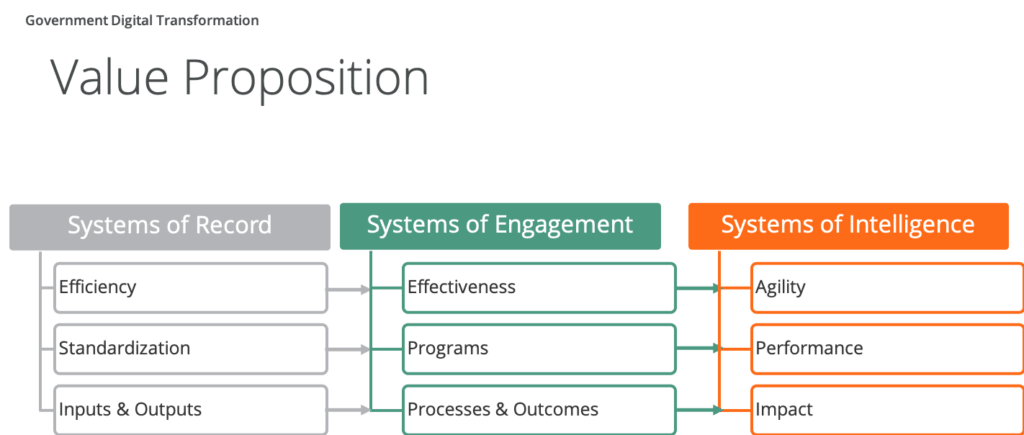Leaders or leadership?
Fundamental organizational change requires leadership. People who exercise leadership. Senior government leaders can enable leadership. Successful government digital transformation relies on senior leaders enabling experimentation – giving space for public servants to exercise leadership.
Forget traditional government organizational management styles. There’s a digital change afoot.
Management style modernization
Senior government leaders and managers enable change. Management styles adapt to the government and country contexts. And, the information technology and Government Resource Planning (GRP) contexts, as governments modernize to support innovation.

Systems of Record focus: compliance and controls
- Command and Control reflects a traditional top-down approach to management designed to ensure following directives
- Vertically integrated reflects the idea that the government can do all things
Systems of Engagement focus: inclusivity
This management style limits transformation of any type. Therefore, leaders leverage these systems as technology foundations for modernization across the entire budget cycle. Systems of Engagement enable governments to engage with public servants and citizens
- Decentralized supports decision discretion by public servants without compromising legal compliance
- Virtually integrated reflects the idea that governments need assistance to achieve policy goals from civil society, businesses, contractors, and other partners
Systems of Intelligence focus: evidence
This management style supports government performance improvement by extending communications and engagement. Leaders accept that governance expertise extends beyond central government, and technocrats from specialized ministries, departments and agencies. Line ministries and sub-national governments contribute to performance improvement through decentralization. Partners contribute to performance improvement. Engagement, collaboration and transparency technology enable this management style. Systems of Intelligence enable governments to discover important insights
- Data-driven supports evidence-based decision-making rather than dogma-based by leveraging insights generated through government and non-government data
- Consultative leverages the network of government organizations, civil society, and other partners across the budget cycle from policy planning through to outcomes analysis
Systems of Innovation focus: empowerment
This management style extends engagement to consultation. Evidence is used to inform government policy, spending, and execution. Data is shared, typically through transparency portals, to improve the quality of consultation with line ministries, sub-national governments, civil society, businesses, and other partners. Analytical technology including big data, machine learning, and visualization enables this management style. Systems of Innovation include:
- Agile supports the ability of leaders and managers to adjust quickly and systematically to economic, social, environmental and political changes
- Networked extends engagement across the budget cycle to every aspect of government to improve public sector innovation, and provide conditions to improve business innovation
This management style also enables government leaders to address a “social mess” or “wicked problems“. As described by Robert Horn, a social mess includes the following characteristics:
- No unique “correct” view of the problem
- Different views of the problem and contradictory solutions
- Most problems are connected to other problems
- Data are often uncertain or missing
- Multiple value conflicts
- Ideological and cultural constraints
- Political constraints
- Economic constraints
- Often a-logical illogical or multi-valued thinking
- Numerous possible intervention points
- Consequences difficult to imagine
- Considerable uncertainty, ambiguity
- Great resistance to change
- Problem solver out of contact with the problems and potential solutions
Systems of innovation rely on process change, from “waterfall” to “agile”. This is enabled by emerging collaboration technology, and leveraging existing government IT systems in new ways.
Government value modernization

Many government leaders recognize that the public sector governance landscape has changed. Citizens have access to far more information. Civil society has become more demanding for improved government performance. Expectations are changing.
Systems of Record support expectations that government services are:
- Efficient through automation to optimize citizen services processing
- Standard through controls and workflow to provide identical quality of services regardless of context
- Input and Output are measured where budgets are developed as inputs, and the number of outputs is tracked
Systems of record are ideal to provide these characteristics to governments. These are “table stakes” expectations for almost every government on the planet. And, these characteristics are not necessarily indicative of service quality or government performance.
Systems of Engagement support the next stage of performance improvement through understanding:
- Effectiveness based on citizen experience adds context to efficiency because process productivity may not necessarily improve service quality
- Programs that are shared across government organizations, codified in financial metadata, in support of policy that gives a more comprehensive picture of government activity
- Outcomes that focus on real results of policy implementation enabling program evaluation
This level of modernization helps government leaders to question conventional wisdom. For example, a health care system that focuses on efficiency measures, like wait times, standardization measures like wait times by region, and output measures, like the number of patient processes, may have no relationship to whether citizen health has improved. A program approach can link prevention to outcomes.
Systems of Intelligence provides analytical insight for:
- Service Delivery through connecting process efficiency and effectiveness statistics with feedback from multiple sources, like social media feeds, to identify metrics that matter
- Performance metrics, including Key Performance Indicators, embedded in financial and budget classifications, to provide near real-time understanding of government performance
- Predictive Outcomes through the use of machine learning applied to unstructured and structured big data to inform government policy
These systems enable governments to escape the tyranny of dogma, and so-called “best practices”. This is particularly important in emerging nation governments who are faced with reform fatigue. Donors often fund projects that are not aligned with government objectives.
Systems of Innovation enable government, civil society, and business impact through:
- Personalization of government services, that are more effective than standardized services
- Sustainable Growth focus where performance metrics and spending is aligned to government objectives
- Citizen Well-being where government objectives are aligned to the social, cultural, and economic context of citizens
Agility is a hallmark of innovation. Agile systems provide more granular measurement. Bottlenecks are identified quickly. Agile processes uncover unexpected “externalities”. The digital leader’s mindset requires leveraging agile techniques such as lean, SCRUM, Kanban, design thinking and PDIA, adapted for the government context.
